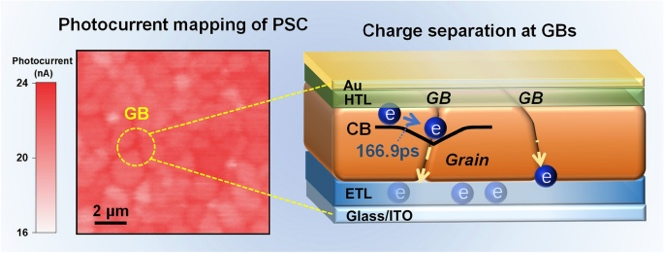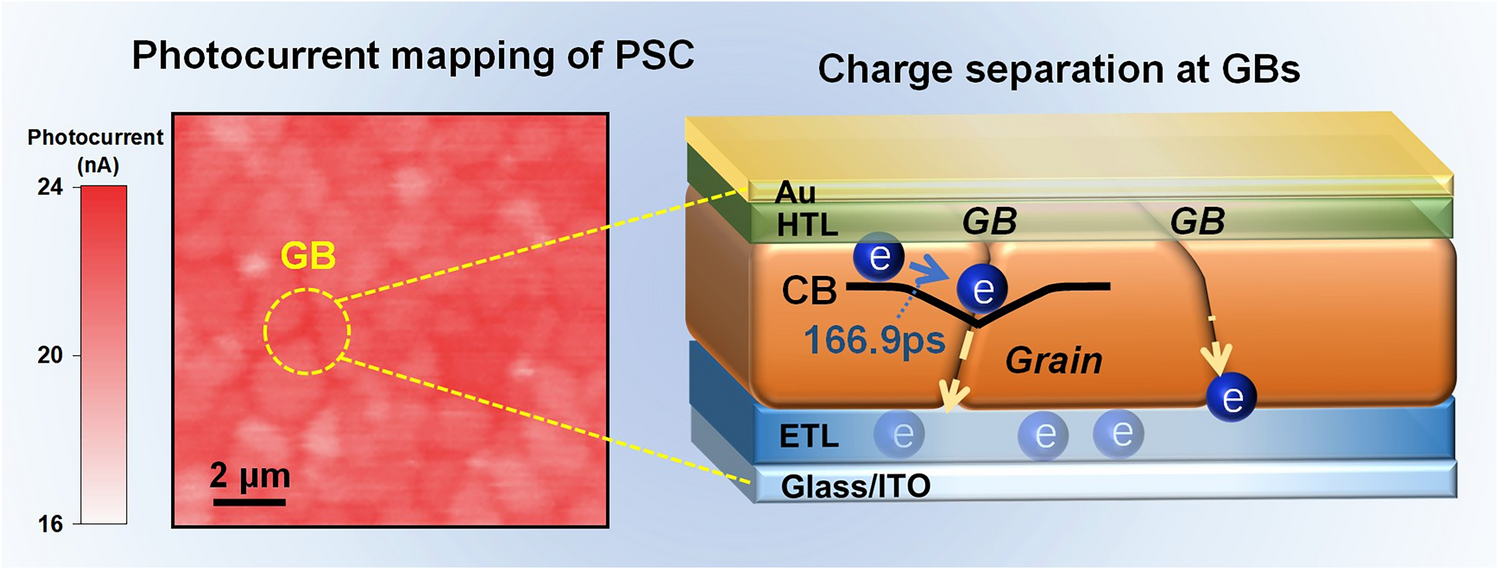Grain Boundaries Contribute to the Performance of Perovskite Solar Cells by Promoting Charge Separations
Published in Materials

In a recent study published in Nano-Micro Letters, a collaboration led by Prof. Wenming Tian and Prof. Shengye Jin (Dalian Institute of Chemical Physics, CAS) and Prof. Yantao Shi (Dalian University of Technology) challenges the long-held belief that grain boundaries (GBs) in perovskite solar cells (PSCs) are detrimental to performance. Using operando, sub-micrometer imaging, the team reveals that GBs in high-efficiency devices can act as charge-separation “highways,” boosting photocurrent and aiding carrier extraction.
Why This Research Matters
- Direct evidence in operating devices: High-resolution confocal photoluminescence and photocurrent imaging show enhanced photocurrent at GBs with a clear anti-correlation to PL intensity—evidence of GB-driven charge separation.
- Built-in electric fields: Kelvin probe force microscopy detects strong local fields (102–103 V·cm⁻¹) at GBs, while transient absorption microscopy confirms ultrafast electron–hole separation (~167 ps) and a threefold longer lifetime of separated states at GBs (~14.5 ns) compared to grain interiors (~5.0 ns).
- Performance correlation: Devices with higher efficiencies (up to 22.45% PCE) exhibit greater GB-induced photocurrent enhancement (~5%) than lower-performing devices (~1.4%).
- Design insight: Rather than eliminating GBs, engineer them—passivate traps but preserve beneficial built-in fields to enhance carrier extraction.
Innovative Design and Mechanisms
- Operando correlative mapping: Custom-built imaging on thin ITO substrates achieves ~300 nm PL and ~500 nm photocurrent resolution in full device stacks, capturing real GB effects under realistic, bias-free conditions.
- Field-guided transport: GB-induced band bending channels electrons and repels holes, creating preferential carrier pathways and reducing recombination.
- Processing–function link: Adjusting annealing times modifies GB crystallinity and defect density, tuning the local electric field and net performance contribution.
Applications and Future Outlook
- Perovskite film optimization: Focus on GB engineering rather than removal to maximize their positive role in high-PCE devices.
- Module manufacturing: The operando imaging approach offers a powerful screening tool for scalable production.
- Cross-material relevance: The GB-field concept can extend to other polycrystalline optoelectronics such as CdTe, CIGS, and thin-film transistors.
By reframing grain boundaries from a problem to a design opportunity, this work provides a new direction for advancing perovskite photovoltaics toward higher efficiency and stability.
Follow the Topic
-
Nano-Micro Letters

Nano-Micro Letters is a peer-reviewed, international, interdisciplinary and open-access journal that focus on science, experiments, engineering, technologies and applications of nano- or microscale structure and system in physics, chemistry, biology, material science, and pharmacy.






Please sign in or register for FREE
If you are a registered user on Research Communities by Springer Nature, please sign in